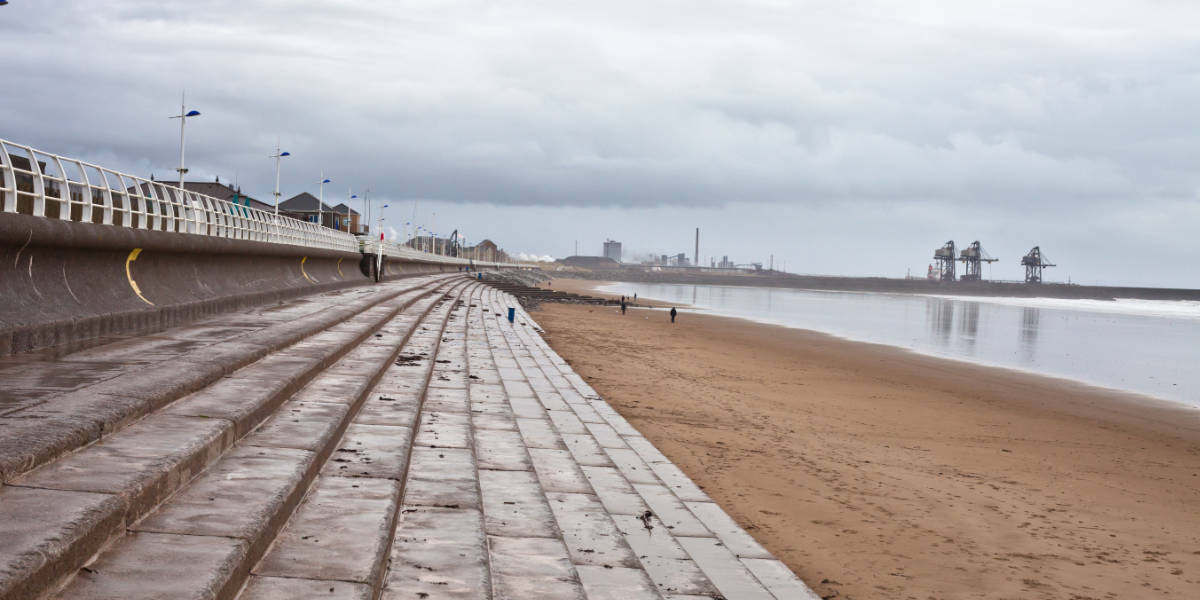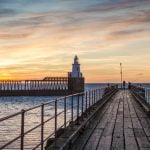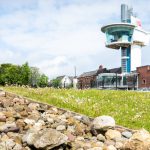
Looking for your next big adventure? UK port towns like Port Talbot are always filled with seaside memories.
Port Talbot lies on the east side of Swansea Bay, on the southern coast of Wales. This industrial location has long been famous as a major manufacturer of coal and steel. Port Talbot has around 37,000 residents, many of whom rely on either the steelworks or the tourist industry to create jobs. Let’s take an in-depth look into this stunning port town to see if it will make a great UK holiday destination for your family.
Let’s get to know Port Talbot intimately, starting with the good old days.
The Early Years of Port Talbot
The Port Talbot historical society traces the origins of the town as far back as 10,000 BC when hunter/gatherers patrolled the shore looking for food. In 4,000 BC, a team of Neolithic farmers occupied the land. Evidence shows they built stone circles for the Gods and grew crops as well as tending animals. Archaeologists uncovered evidence of Bronze Age tools in the area, as well as ornaments and weapons. The Celts arrived here in 600 BC, during the Iron Age. They created the hill forts at Margam and Baglan, showing that even before the birth of Christ, we knew that the hills on the coastline of Margam were of strategic importance. The Celts brought roundhouses and fields.
Although the Romans arrived in Britain in AD 43, they didn’t invade Wales until about AD 60.
The Welsh Tribes in Swansea Bay
When the Romans arrived in Britain, they did a quick reconnaissance of Wales. Their mapmaker charted out only 6 tribes, one of which was the warlike Silures tribe. The Silures made life difficult for the Romans by continuing to resist their rule. They raided along their borders and even gathered an army to beat the Romans back. In the end, the Romans ‘took’ Wales but struggled to police it because of the ferocity of the Welsh savages. Some of the old kingdoms even held out. When the Romans finally retreated in the fourth century, they left behind a framework for roads and a few kingdoms who were happy to see them go.
The Silures fought the Romans under an army assembled by Caratucus of the Catuvellauni. Perhaps you have heard of him? If not, let’s return to the town and its history.
Pre-Medieval Port Talbot
Before Port Talbot got its name, the town suffered raids because of its coastal position. The Vikings raided up and down the Welsh coast and the Irish raided along the same paths. History records a Breton Prince named St Baglan, who went to work at a Christian Monastery in Wales. He later founded the church at Baglan. A second saint comes from the area. Saint Sawel founded the church at Briton Ferry.
During this time, the first bridge to Briton opened. It was likely wooden unless the Romans rebuilt it in stone. Archaeologists excavated the area where the docks are now in 1836 to find Roman coins, stone mason’s work, and evidence of a church that pre-dates all of this. To be blunt about it, this area of land has seen constant occupation since before recorded history. When the Normans came in 1066, the Welsh were ready for the fight.
The Normans didn’t arrive in Wales until 1090 when they already controlled much of England. Of course, the Welsh fought them off. The leader Rhys ap Tudur was the king of South Wales and he died in battle. Later, Iestyn ap Gwrgan similarly dies, but his son is gifted the lands between Neath and Ffrwdwyllt. He became the first lord of Afan. His name was Caradoc. He built a wooden motte and bailey castle on the site of St. Mary’s church.
The Medieval Era
In 1137, Robert, Earl of Gloucester, founded Margam Abbey. The building work finished in 1147. He wanted it to act as a neutral zone to give himself a buffer between he and Wales. By 1153, Caradoc’s castle burned to the ground. Legend holds that his brother in law was the culprit. He rebuilt his wooden castle out of stone just like the three little pigs. In 1170, the town held a Grand Eisteddfod celebration.
In 1171, Henry II passed through on his way to invade Ireland. The irony was real.
By 1188, the leaders of the land are marrying Normans and taking their names. Gerald of Wales visited Margam, and the Archbishop of Canterbury came to see the holy houses. By 1210 King John was visiting to do the same. By 1232, local tensions bubbled over and Morgan Gam, lord of Afan, attacked Kenfig. In 1249 the monks of Afan mined coal for the first time. Edward II came to their abbey in 1326. In 1347, an outbreak of the Black Death wiped out about 20% of the population. The Black Death came in three waves.
Royal Visit
Richard II visited the abbey in 1394 and again in 1399. The castle which housed the Lords of Afan lies empty. Nobody is sure where they went. The archbishop had campaigned here for crusaders for his holy war. It’s possible they went to it and never returned home. The historical society records serious flooding in 1491 and 1492. A few years earlier, the monks complained to King Edward II that no part of the town here was safe from the inundation of the sea.
Fishermen operated here from the first lease in 1509 and the dissolution of the monasteries impacted the abbey as of 1535. Two years later, they had to go and throw the remaining monks out of it. In 1547 Sir Rive Mancel of Oxwich bought the abbey. He turns it into a house. They bought coal pits the previous years. Margam Park opened in 1558 and the Ann Francis washed ashore wrecked in 1583. Locals constructed Baglan Hall in 1600 and in 1601 the first poor laws came into action. In 1648, Oliver Cromwell visited Aberavon. Another coal mine opened.
Fun Facts About Port Talbot
We like to review the fun things to see and do in our tours, yes – but far more important than that is the local gossip. In this section, you should find all you need to know to astound the local populace with your wicked knowledge. Fun trivia about Port Talbot includes:
- The Port Talbot Steel Works opened its doors in 1901 and still generates 5 million tonnes of steel slabbing, every year. It is one of few steel works in and around south Wales that still operates. Most closed down at the end of the industrial revolution, or during the early 1900s.
- The deep-water harbour here is an important resource for the steelworks. It can transport up to 100,000 tonnes of steel at any given moment.
- Although famous for its steelworks, the town grew up around Margam Abbey. It opened in 1147. The Abbey growth changed to industrial growth circa 1740 when the local collieries opened.
- Port Talbot became a popular seaside resort in the 1900s, despite all this industrial activity. If you look north from the beach instead of south, you can still pretend the steelworks isn’t there…
- The town played host to a radar monitoring station during the war. You can still see it if you head out to the Margam Coast Defence Radar station. It’s dilapidated now, but still a cool reminder of wartime past.
Let’s forget about the slightly gloomy fun facts about Port Talbot. It’s obviously not as cheery a place as we first thought. It’s those steel works, overshadowing everything. Let’s get back to the Industrial heritage and see if we can spot some fun facts there.
Industrial Era Port Talbot
Afan Forge opened in 1717, beginning the town’s long and prosperous coal mining and smelting history. They held the Eisteddfod in 1735 to celebrate. The first Talbot, Thomas Mancel Talbot, was born in 1747. The family would grow to give the town their name. The Mansel line died out in 1750, passing to Thomas, who was now a reverend. Collieries opened at Lletty Harry and Mynydd Bychan. In 1765, Baglan House opened and in 1762, locals constructed Ty Mawr. The first tollgate was in Bethany Square and opened in 1764. The Aberavon bridge swept away in 1788, along with St. Mary’s Church.
In 1774 the Taibach copperworks opened. Tir Caradog opened, and the Underhill House saw completion. The Somersetshire Hotel opened this year, with collieries added throughout the next two decades all over the area. In 1793, the Magram Orangerie opened and houses were added to town. In 1799 the local Chapter House roof collapsed.
Lord Nelson
By 1800, the town had a population of 2175. Admiral Nelson visited in 1802 and in 1803 CRM Talbot was born. Steam-powered mills powered the copper works from 1804 and the tramway opened in 1808.
Thomas Mancel Talbot died in 1813 and a bread famine hit the same year. Glenavon House opened in 1816, followed by the first Cwmavon blast furnace three years later. Margam tinworks opened in 1822 and horse-drawn trams began. A second tinworks opened in 1825, along with a chemical plant at Cwmavon. A charity school opened in 1829 and a second followed in 1831. Margam Castle opened in 1835 after CRM Talbot finished it.
The town saw Cholera epidemics in 1832, 1849, 1855, and 1866. Aberavon was notably a dirty town at the time. The first docks arrived in 1836 and Taibach got its own market in 1839. Engineering workshops, blast furnaces, copper mills, mines, and gas works all took place over the next fifty years or so. In the late 1800s, the town was a bustling hive of activity. It wasn’t pleasant in terms of air quality. The local poor worked in mills or poorhouses. In 1845, the disease set into the potatoes and did damage to the population. Otherwise, the town continued to grow throughout the century.
Modern Day Port Talbot
By 1901, the town was still going strong. The steelworks opened and brought a wealth of work to those who had just finished in the coal mines. The North Pier opened in 1902 and locals built a customs house. Ship the Christina ran aground near the coast and 6 members of the local lifeboat team died trying to recover her. The copperworks started to close with the shutting of the Rio Tinto works at Cwmavon.
In 1907 the old market burned down. The Eagle Brickworks opened. Aberavon FC opened their stadium grounds. In 1908, the Amazon washed ashore, killing 21 people. The Trafalgar then ran aground on Aberavon Beach. Canister Bridge was swept away in high rain in 1909. The Gas Works opened and a second brickworks followed in 1910. The villages of the area gave heavily of their young men during WWI and WWII. Indeed, the town even had a home front, where they manned the radar station and helped if they could.
Modern Port Talbot has suffered for its industrial past. In the fifties, a coal creosote spill wiped out the fish stocks in the Afan. Sea walls and a new dock have outfitted the front to protect it from the high flooding of old. New schools replace the new copper works and the town has built hotels, a beautiful beach, and shops fit for tourists all along the front. We highly recommend a visit to see what the land does after years of industry. We expect you will find it far prettier than you might expect.
Famous People from Port Talbot in Wales
We can’t possibly move on to the tourist attraction in Swansea Bay before we have talked about the famous people you might meet when you go to visit them. Here are the famous faces from Port Talbot that you might meet at the market:
- Would you believe that Sir Anthony Hopkins was born here? We didn’t even know he was Welsh.
- Actor Bernard Fox is from here, as is Clive hill
- Model Lateysha Grace was born in Port Talbot
- Poet and writer Gwyn Williams
- Welsh painter living in France Andrew Vicari is a Port Talbot man
- Famous botanist David Smith comes from here
If you don’t meet Anthony Hopkins at the supermarket, we would be disappointed on your behalf. Let’s leave that potential sadness behind us and move on to the section we all love best – what things should you see and do if you are visiting Port Talbot?
The Best Attractions in Port Talbot
Whether you are just passing through or spending a week here, there are plenty of things to see and do. Here are some of our top sites in Port Talbot for you to explore.
Margam Castle

Image: Billy Stock/Shutterstock.com
Yes, Port Talbot has its own castle, and an impressive site it is too! This is one of the finest examples of Tudor Gothic architecture in the region and dates from 1840. It is Grade I listed and is worth a visit just to see the staircase hall! It was badly damaged by a fire in 1977 but has been lovingly renovated.
An additional benefit is that it is set in Margam Park so you can multi-task – see the architecture and then enjoy the great outdoors!
Margam Abbey
You can’t come to the area without stopping at the Margam Abbey for a look. This is a gorgeous old building about a mile and a half from the steelworks, out of sight and sound of them. The abbey is still in use as a ministry today, so although you can browse the grounds and buildings, you must be quiet and respectful while you are there. It’s a great place to visit but we are not sure we would take the kids.
Galleries and Museums
When it comes to unusual, the people of Port Talbot don’t like to be beaten. Never was this truer than when they were picking their museums. To this day, you can visit the Baked Bean Museum of Excellence. As far as we know, it is the only museum in the world dedicated to the humble haricot. Run by Captain Beany, this museum is ideal for all of those that want to learn something but have a good laugh while they are doing it.
Another beautiful idea for a museum is the Margam Stones Museum. This museum houses the Margam stones, a series of early Christian stones which were housed in the medieval abbey church. You can visit them here while touring the church and old abbey, which is kind of a historical attraction and a museum mixed into one. The Margam stones were originally standing stones that marked the way back to Rome from Wales. There is also a selection of 9-10th century crosses here.
Sports and Recreation
Everyone loves to get outside and enjoy nature. However, some of us like to do it with a bit more thrill attached. To do this in Port Talbot, head to the Go Ape forest canopy adventure wonderland and get hanging.
If hanging out in the trees isn’t your thing, don’t panic. This is a Welsh town, there is plenty of rugby going on. Port Talbot has three RFCs you can visit. There is Baglan RFC, Aberavon Harlequins RFC, and Taibach RFC. Take your pick. Alternatively, you can root for the Port Talbot Town Football Club, instead.
There is the British Steel Port Talbot golf club, the Lakeside Golf Club, the Pirate cove Adventure Golf Club – ideal for kids – or Robert Evans Professional Golf Shop at Lakeside. All will give you insight into golf in Wales.
If you love nature and the great outdoors, you can also visit the Afan Forest Park and take advantage of the hiking and biking there. There is a mountain bike company that operates in the area, so you can rent a bike and go explore.
Outdoor Attractions
One of the best-known sites in town is Margam Park. Originally built back in the 1800s, this park is still going strong today. This country park contains world-famous gardens and wildlife sessions for the little ones. They regularly run events here, and you can go for a day trip to tour the house and grounds. Otherwise, just enjoy the acres and acres of woodland, meadow, and ambling brooks.
If you are a bird watcher you will love it here as there is a thriving population of Skylarks. A species which is sadly in decline in much of the UK.

Image: J.M.Abarca/Shutterstock.com
It wouldn’t be a port town if it didn’t have a great beach to attract tourists. You can enjoy sunbathing or sports on Aberavon Beach, named for the small village Port Talbot used to be before the Talbot family became involved. Aberavon is renowned for being one of Wales’ longest beaches. It is a real sand beach too, so take the bucket and spade when you go.
Shopping and Retail
There are shops everywhere in Port Talbot. Choose to shop at the Baglan Bay Retail Park, at the Parry Road Shops, or in the Aberafan Shopping Centre. You can even hang out on the promenade for more shops, bars, restaurants, and cafes, or delve into the centre of town for yet more gift stores.
Other Attractions in Swansea Bay?
If you are spending any longer than a week here, then you need other things to see and do. Check out these attractions if you are stopping by for a while:
- Visit the Afan Lido, which has a swimming area for kids along with a leisure centre attached.
- Visit the Paint Pot and get artsy
- Join in the surfing lessons given by the local surf school
- Enjoy a game at Battlefield Live in Neath
How to get to Port Talbot?
We are nearly at the end of our exploration into Port Talbot, but it occurs to us that you can’t do any of it if you don’t know how to get there. Here are some of the worst directions you have ever been given, please use your sat nav or call a taxi.
By Road
If you leave London and head west along the M4 you will eventually pass through Port Talbot.
By Rail
The train station is Port Talbot Parkway.
By Air
Your nearest airport is in Cardiff.
By Sea
Head for Port Talbot though be prepared for industrial docks.
Five Minutes Spare
We are a wholesome (and awesome) media company that bring you all the latest news, sports, and entertainment in the UK. Why aren’t you following us yet? Find us on Insta or Facebook to keep reading about all the cool things you could be doing with your weekend. When it comes to exploring the UK, we have got you covered.




